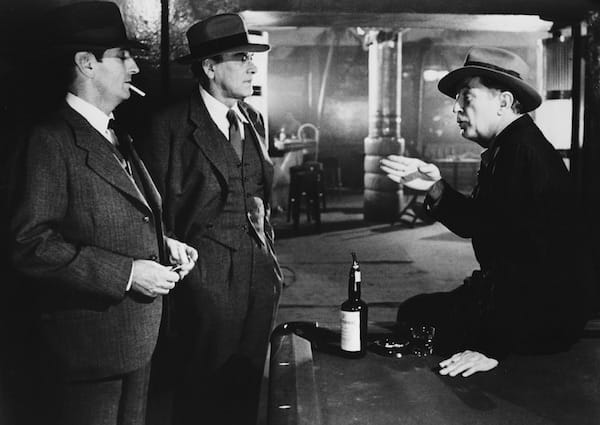
To discuss film with Alan K. Rode is to experience a living, breathing encyclopedia.
Classic cinema is in Rode’s DNA. It would have to be — as the longtime director/programmer of the Arthur Lyons Film Noir Festival, Rode can see your reference to Peter Lorre and raise you a pot of gold loaded with facts about the Sydney Greenstreet, Victor Mature, Ruta Lee, or Billy Wilder, among countless others.
Most people are eager to learn more. Which is where the festival comes in.
Founded in 2000 by the late Arthur Lyons, the festival screens an inventive mix of classic film noir. This year’s event runs May 10–13 at the Camelot Theatres in Palm Springs. As in previous years, special guests will be in attendance, including Jack O’Halloran, who portrayed Moose Malloy in Farewell, My Lovely (1975), the fest’s opening-night feature. Out of the 12 films being presented, 11 are black and white and 10 are 35mm prints.
The Red House (1947, United Artists, screening May 12 at 1 p.m.) is already generating buzz. The film stars Edward G. Robinson and a 19-year-old Julie London. Missing for decades, it was recently restored by the UCLA’s Film and Television Archive, and the new version has never been seen by audiences. Rode considers it “one of the great gothic noirs,” with an evocative score by Miklós Rózsa.
Of course, there are plenty of other standouts. Rode shared with us the allure of the festival and some of the key ingredients to its longevity.
What do you feel is the fascination of black-and-white films, and why is it important to take note of them?
The sweet spot for film noir was right after World War II, up until the 1950s and ’60s. The themes of existilism, nihilism and lust are timeless. These films were made during an era where America left its adolescence and got older and grew up. There is still a resonance.

Jack O'Halloran will be the opening-night guest May 10.
Are you seeing a difference in the crowds that attend?
More younger and younger people gravitate toward these films, which means there is life after people in my generation step off the mortal coil and go on.
There’s universal appeal, too, though.
There is something there for everyone, both in story sense and a dramatic sense and an actor sense. When you look at some of the people in these movies, like our opening feature with Robert Mitchum, playing a very aging private eye, Philip Marlowe, from Raymond Chandler’s famous novel Farewell My Lovely. He gives such a definitive portrayal because it was at the end of his career, and it’s an unusual portrayal. It’s hardly been shown. Even thought it’s a color film, it has that feel of 1941 Los Angeles, replete with crooked cops, gambling, and lowlife. These films appeal to audiences in ways that spans generations.
Are you finding it challenging to find guests and actors who starred in those older films?
Over time there aren’t many people that are alive who appeared in movies in 1947. There’s a good many neo noir films that are out there. I always try to look for a guest who isn’t always related to somebody and their own body of work and who has a perspective on their relative mother or father, or whoever that is, and adds something complementary to the show.

"These movies have a look and a feel that does not exist any more." — Alan K. Rode
What makes for a great black-and-white film?
The commonality between these movies is the fact that the camerawork and the lighting were designed to set a certain mood and convey characters and emotions. Increasingly, I think movies now are lot like television shows: very brightly lit, a close-up, a two-shot, a master shot, and it’s pretty much meat-and-potatoes filmmaking. A film like Michael Curtiz’s The Unsuspected, which plays at 4 p.m. on May 11, was made in 1947, and it’s really a dazzling display of camerawork, and the use of lighting by Curtiz, who is a master director.
A rare treat.
They don’t make movies like this anymore. The equipment is completely different; the technology has completely changed. These movies have a look and a feel that does not exist any more. Because of the censorship rules in those days, the screenwriters had to be much more creative on suggesting stuff like infidelity or sexual obsession, brutality, and so on. You could not blatantly show these things on screen. Certain topics and shots were considered salacious or forbidden. That led to a lot of subtlety in how plot points and storylines were presented. But one of the best things about that is the fact that a lot of these films are well written, with excellent dialogue, and the storylines are ones you have to pay attention to. There’s a lot of subtlety to them.
What do you love most about what you do?
Oh my. I’ve been doing this a long time. In the beginning, I didn’t know what the hell I was doing. I walked around saying, “We can’t find any of these films.” And now, it’s become so much easier. Everything is built on relationships. The best thing about Palm Springs is that it’s a renewal of relationships I have had for many years. It’s such a privilege to be doing this. I also love that people come from everywhere — from Australia to Canada — and we are not only showing films that we are saving, we are saving the experience of showing these movies in a theater on a big screen in 35 mm. This festival is really a communal experience.
The Arthur Lyons Film Noir Festival runs May 10–13 at Camelot Theatres, 2300 E. Barista Road in Palm Springs. For more information and tickets, visit arthurlyonsfilmnoir.ning.com.